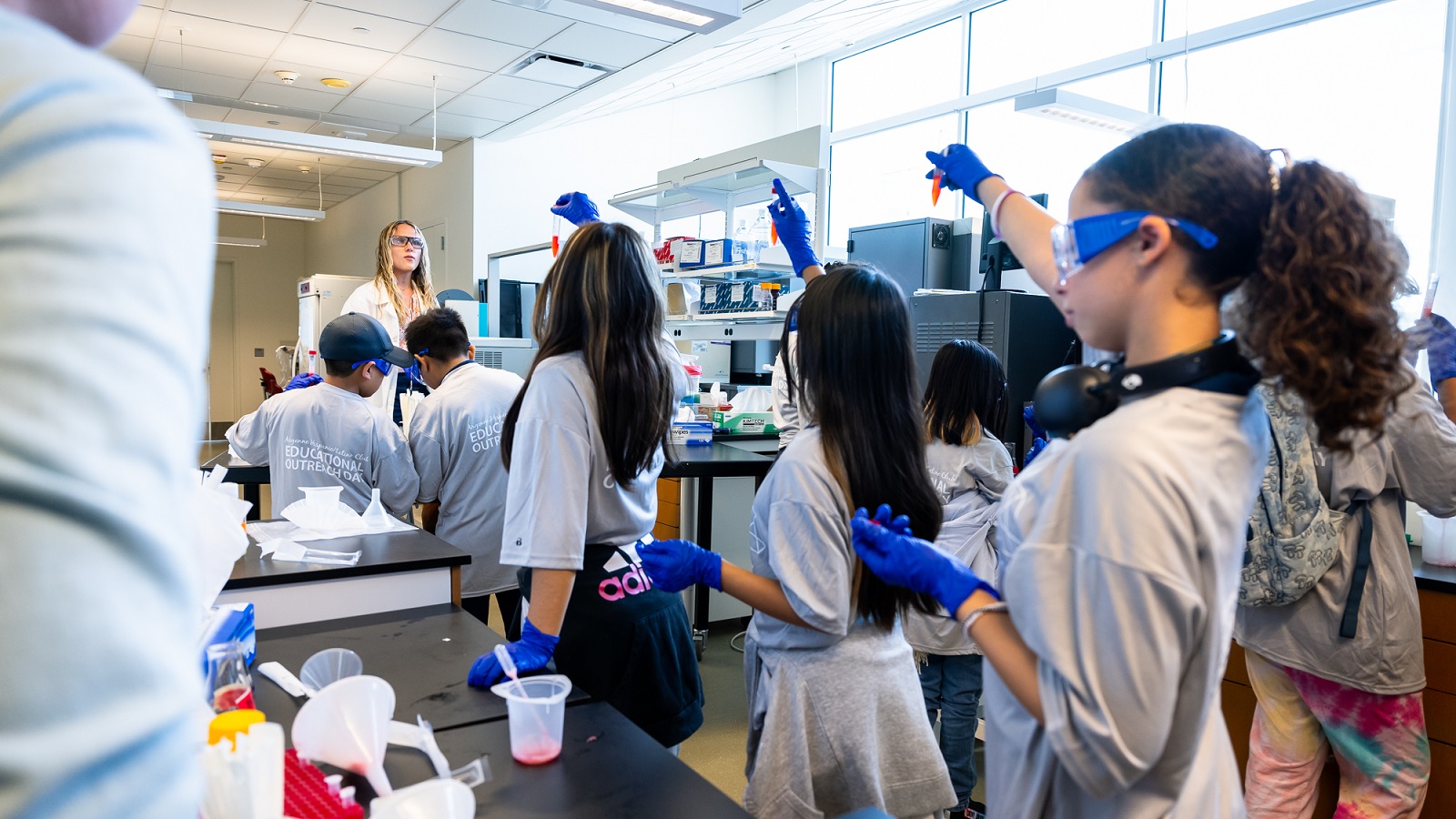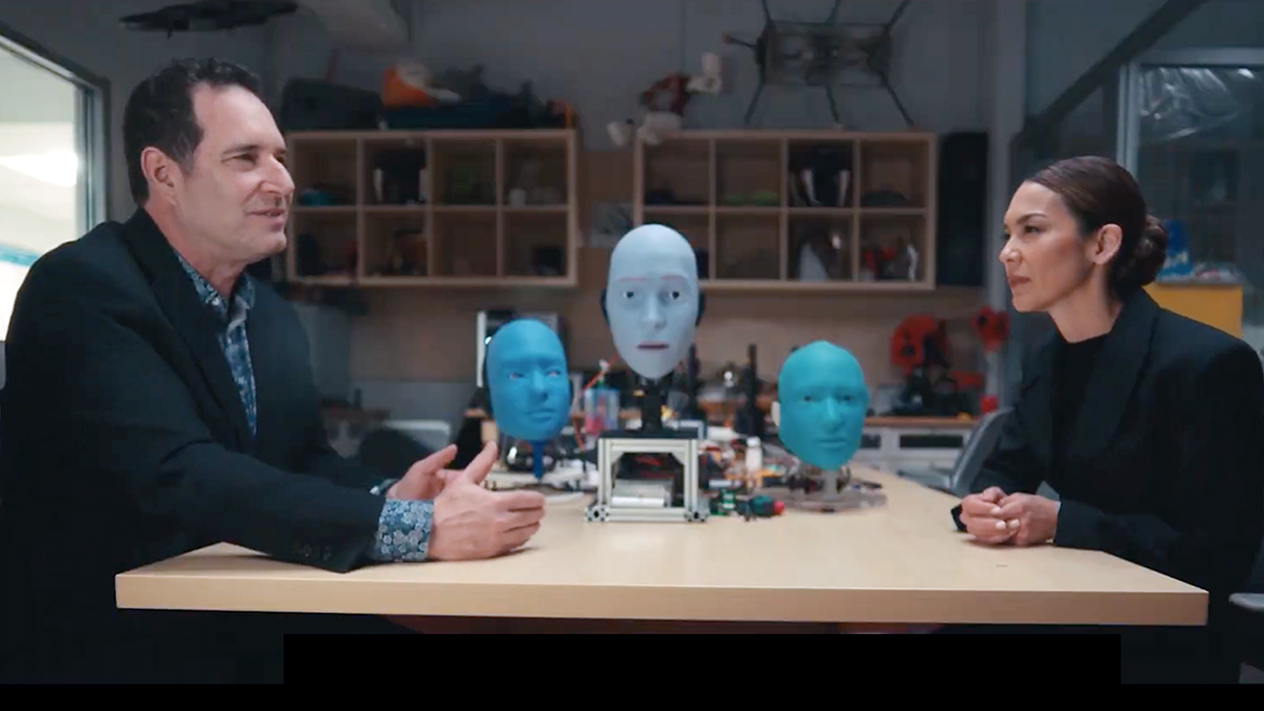One young learner’s response was immediate: “Bill Nye!” he exclaimed.
Bill Nye The Science Guy: a bona fide science celebrity! Could Mr. Nye be influencing a future Latino STEM star?
In October, Argonne welcomed about fifty sixth-grade students and their teachers from the Harriet Beecher Stowe Dual Language School, located in Chicago’s Hermosa neighborhood. The event aimed to spark students’ interest in science, technology, engineering and math (STEM).
“I’ve been at Argonne for 26 years. It’s been a great place to work, and I’ve been able to participate fully in my own kids’ lives. A STEM career can provide those kinds of opportunities to all of you, too.” — Michael Kaminski, Argonne senior nuclear chemical engineer
This annual event, now in its 19th year, is part of Argonne’s outreach efforts during Hispanic Heritage Month, led by a team of employees from Argonne’s Hispanic/Latino Club (AHLC). Each year, the team invites students from local schools to visit the lab, where they interact with mentors who are scientists and professionals of Hispanic and Latino heritage. These mentors act as role models and guide students through hands-on science challenges, lead activities and answer questions.
By connecting with students from communities that are often underrepresented in STEM, Argonne aims to inspire a lasting interest in science and technology. This initiative helps pave the way for students to explore STEM education and, ultimately, careers in these fields.
An invitation to the big STEM table
For members of the AHLC, such outreach is personal.
In his welcoming remarks, Michael Robledo Kaminski, a senior nuclear chemical engineer and AHLC Employee Resource Group (ERG) president, explained, “I spent a lot of time on the South Side at 26th and Keeler. My dad worked in the factory in that neighborhood, and my mom lived in that neighborhood when she emigrated from Mexico and before they were married. My parents worked the overnight shifts at their jobs when my brother and I were growing up, so much so that I only saw my dad on weekends. They worked really hard so we could have better opportunities.”
Before dispersing the students to the next step in the day’s itinerary — visiting several learning lab sites across campus — Kaminski drove his point home: “I’ve been at Argonne for 26 years. It’s been a great place to work, and I’ve been able to participate fully in my own kids’ lives. A STEM career can provide those kinds of opportunities to all of you, too.”
Guadalupe “Lupe” Franchini has had a 43-year-long career at Argonne and holds the esteemed role of executive assistant to Laboratory Director Paul Kearns. Explaining her involvement in the AHLC ERG, she said, “I want to see the next generation of Latino students empowered to realize their potential. When they are, they’ll be positioned for success: perhaps they will grow up and be the ones to contribute major advances in a STEM field. It can start by showing students that they, too, can thrive in these fields. Our group wants to ignite that passion.”
Vanessa Mendez, a finance manager whose career at Argonne has spanned 42 years, concurred with Franchini. She added, “Awareness about STEM opportunities is key: we want the students to know that putting effort into their STEM classes now can open doors in the future to good careers and economic mobility. For Latino students, these opportunities can help uplift entire communities! Events like this can motivate Latino students to consider STEM as a viable and rewarding career path.”
Exploring different outcomes through hands-on learning
Back in her learning lab, program coordinator Rodriguez was teeing up an accelerator design challenge. First, the students learned that the “ring” around the Advanced Photon Source (APS), a DOE Office of Science user facility at Argonne, is 1 mile around, and the Chicago Bears’ Soldier Field can fit inside it. “It’s basically a big microscope, a big X-ray machine,” she said, “where electric fields are used to accelerate tiny particles called electrons nearly to the speed of light.” A track-like setup with magnetic balls was distributed to each table, enabling each team of students to change several different independent variables (such as magnet sizes) and measure the dependent variable (such as the speed of the balls).
In another room, educational programs Learning Lab Instructor Jacquie Otmanski led a battery design challenge. First, the students learned about the fundamental components of a battery — metals (electrodes), membranes and electrolytes. Using metal layers of copper and aluminum, Gatorade (the electrolyte) and construction paper (the membrane), students created a baseline battery cell and measured the initial voltage and current. Then, teams of students tested different materials and other variables to determine how to optimize a battery that would meet the voltage and current requirements to power a small toy car’s motor. Later in the day, Otmanski demonstrated a successful, student-created battery that was able to power the toy car.
In Kaminski’s learning lab, he explained the different ways electricity is made and delivered to their houses. He contrasted a coal plant’s output to that of a nuclear power plant that uses tiny uranium pellets stacked into 10-foot-long rods to create power. A total of 27 rail cars carrying coal equals just over 2 pounds of uranium in energy output. The exercise involved having the students measure clay powder into a die press to simulate creating uranium fuel pellets.
At a fourth learning lab, DNA Sequencing Specialist Stephanie Greenwald led the students in extracting DNA samples from strawberries, which they then examined under a microscope.
Inspiring curiosity and collaboration
Rae Sharp-Geiger, deputy laboratory director of operations, kicked off the afternoon activities.
“I encourage you to study hard in your STEM classes,” she said. “Science, technology, engineering and math hold many possibilities for your future. Today is an opportunity to explore science, so ask questions, be curious and work with your classmates, because collaboration skills are essential.” Sharp-Geiger concluded by asking, “What is the coolest thing you’ve learned so far today?”
One girl stated, “We got to engage, not just watch.” A boy enjoyed the fact that “we used different materials to make energy.” Marieli Vazquez summed up as follows: “I learned more about potential and kinetic energy and how to see DNA.” However, applause broke out in the conference center at Cataleya Gomez’s takeaway when she stood up to say: “If you fail [at getting a measurement], just keep trying.”
Wrapping up with real-world STEM: Students present discoveries to peers
Perhaps the most impressive aspect of the day was the last segment, which served to reinforce the students’ learning from throughout the day and emulated the professional STEM activity of sharing findings with peers at meetings and conferences.
The students worked in small groups with lab mentors. Each team used a template to create a laptop-based presentation, and then each got up in front of the whole assembly and shared their group’s findings and takeaways. This activity spread and reinforced the learning.
While there was more nervous energy in the room about speaking, the mood was still jovial — a successful conclusion to the day’s working field trip. And only time will tell if a future STEM star will look back and say that a keen interest in a STEM field was launched at Argonne.
About the Advanced Photon Source
The U. S. Department of Energy Office of Science’s Advanced Photon Source (APS) at Argonne National Laboratory is one of the world’s most productive X-ray light source facilities. The APS provides high-brightness X-ray beams to a diverse community of researchers in materials science, chemistry, condensed matter physics, the life and environmental sciences, and applied research. These X-rays are ideally suited for explorations of materials and biological structures; elemental distribution; chemical, magnetic, electronic states; and a wide range of technologically important engineering systems from batteries to fuel injector sprays, all of which are the foundations of our nation’s economic, technological, and physical well-being. Each year, more than 5,000 researchers use the APS to produce over 2,000 publications detailing impactful discoveries, and solve more vital biological protein structures than users of any other X-ray light source research facility. APS scientists and engineers innovate technology that is at the heart of advancing accelerator and light-source operations. This includes the insertion devices that produce extreme-brightness X-rays prized by researchers, lenses that focus the X-rays down to a few nanometers, instrumentation that maximizes the way the X-rays interact with samples being studied, and software that gathers and manages the massive quantity of data resulting from discovery research at the APS.
This research used resources of the Advanced Photon Source, a U.S. DOE Office of Science User Facility operated for the DOE Office of Science by Argonne National Laboratory under Contract No. DE-AC02-06CH11357.
Argonne National Laboratory seeks solutions to pressing national problems in science and technology by conducting leading-edge basic and applied research in virtually every scientific discipline. Argonne is managed by UChicago Argonne, LLC for the U.S. Department of Energy’s Office of Science.
The U.S. Department of Energy’s Office of Science is the single largest supporter of basic research in the physical sciences in the United States and is working to address some of the most pressing challenges of our time. For more information, visit https://energy.gov/science.



